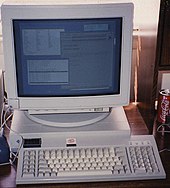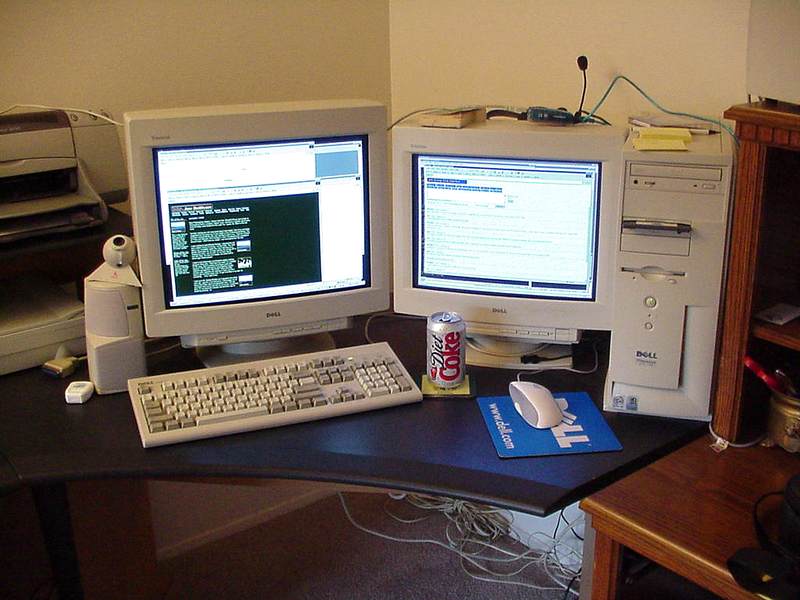COURTESY – Wikipedia
Introduction To The Personal Computer
A personal computer (PC) is a multi-purpose microcomputer whose size, capabilities, and price make it feasible for individual use. Personal computers are intended to be operated directly by an end user, rather than by a computer expert or technician. Unlike large, costly minicomputers and mainframes, time-sharing by many people at the same time is not used with personal computers. Primarily in the late 1970s and 1980s, the term home computer was also used.

Institutional or corporate computer owners in the 1960s had to write their own programs to do any useful work with the machines. While personal computer users may develop their own applications, usually these systems run commercial software, free-of-charge software (“freeware”), which is most often proprietary, or free and open-source software, which is provided in “ready-to-run”, or binary, form. Software for personal computers is typically developed and distributed independently from the hardware or operating system manufacturers. Many personal computer users no longer need to write their own programs to make any use of a personal computer, although end-user programming is still feasible. This contrasts with mobile systems, where software is often available only through a manufacturer-supported channel, and end-user program development may be discouraged by lack of support by the manufacturer.
Since the early 1990s, Microsoft operating systems and Intel hardware dominated much of the personal computer market, first with MS-DOS and then with Microsoft Windows. Alternatives to Microsoft’s Windows operating systems occupy a minority share of the industry. These include Apple’s macOS and free and open-source Unix-like operating systems, such as Linux.
The advent of personal computers and the concurrent Digital Revolution have significantly affected the lives of people in all countries.
The term “PC” is an initialism for “personal computer”. While the IBM Personal Computer incorporated the designation in its model name, the term originally described personal computers of any brand.
In some contexts, “PC” is used to contrast with “Mac”, an Apple Macintosh computer. Since none of these Apple products were mainframes or time-sharing systems, they were all “personal computers” and not “PC” (brand) computers.
In 1995, a CBS segment on the growing popularity of PC reported “For many newcomers PC stands for Pain and Confusion”.
The “brain” [computer] may one day come down to our level [of the common people] and help with our income-tax and book-keeping calculations. But this is speculation and there is no sign of it so far.
— British newspaper The Star in a June 1949 news article about the EDSAC computer, long before the era of the personal computers.

In the history of computing, early experimental machines could be operated by a single attendant. For example, ENIAC which became operational in 1946 could be run by a single, albeit highly trained, person. This mode pre-dated the batch programming, or time-sharing modes with multiple users connected through terminals to mainframe computers. Computers intended for laboratory, instrumentation, or engineering purposes were built, and could be operated by one person in an interactive fashion. Examples include such systems as the Bendix G15 and LGP-30 of 1956, and the Soviet MIR series of computers developed from 1965 to 1969. By the early 1970s, people in academic or research institutions had the opportunity for single-person use of a computer system in interactive mode for extended durations, although these systems would still have been too expensive to be owned by a single person.
The personal computer was made possible by major advances in semiconductor technology. In 1959, the silicon integrated circuit (IC) chip was developed by Robert Noyce at Fairchild Semiconductor, and the metal-oxide-semiconductor (MOS) transistor was developed by Mohamed Atalla and Dawon Kahng at Bell Labs. The MOS integrated circuit was commercialized by RCA in 1964, and then the silicon-gate MOS integrated circuit was developed by Federico Faggin at Fairchild in 1968. Faggin later used silicon-gate MOS technology to develop the first single-chip microprocessor, the Intel 4004, in 1971. The first microcomputers, based on microprocessors, were developed during the early 1970s. Widespread commercial availability of microprocessors, from the mid-1970s onwards, made computers cheap enough for small businesses and individuals to own.
In what was later to be called the Mother of All Demos, SRI researcher Douglas Engelbart in 1968 gave a preview of features that would later become staples of personal computers: e-mail, hypertext, word processing, video conferencing, and the mouse. The demonstration required technical support staff and a mainframe time-sharing computer that were far too costly for individual business use at the time.
Early personal computers—generally called microcomputers—were often sold in a kit form and in limited volumes, and were of interest mostly to hobbyists and technicians. Minimal programming was done with toggle switches to enter instructions, and output was provided by front panel lamps. Practical use required adding peripherals such as keyboards, computer displays, disk drives, and printers.
Micral N was the earliest commercial, non-kit microcomputer based on a microprocessor, the Intel 8008. It was built starting in 1972, and a few hundred units were sold. This had been preceded by the Datapoint 2200 in 1970, for which the Intel 8008 had been commissioned, though not accepted for use. The CPU design implemented in the Datapoint 2200 became the basis for x86 architecture used in the original IBM PC and its descendants.
In 1973, the IBM Los Gatos Scientific Center developed a portable computer prototype called SCAMP (Special Computer APL Machine Portable) based on the IBM PALM processor with a Philips compact cassette drive, small CRT, and full function keyboard. SCAMP emulated an IBM 1130 minicomputer in order to run APL/1130. In 1973, APL was generally available only on mainframe computers, and most desktop sized microcomputers such as the Wang 2200 or HP 9800 offered only BASIC. Because SCAMP was the first to emulate APL/1130 performance on a portable, single user computer, PC Magazine in 1983 designated SCAMP a “revolutionary concept” and “the world’s first personal computer”. This seminal, single user portable computer now resides in the Smithsonian Institution, Washington, D.C.. Successful demonstrations of the 1973 SCAMP prototype led to the IBM 5100 portable microcomputer launched in 1975 with the ability to be programmed in both APL and BASIC for engineers, analysts, statisticians, and other business problem-solvers. In the late 1960s such a machine would have been nearly as large as two desks and would have weighed about half a ton.
Another desktop portable APL machine, the MCM/70, was demonstrated in 1973 and shipped in 1974. It used the Intel 8008 processor.
A seminal step in personal computing was the 1973 Xerox Alto, developed at Xerox’s Palo Alto Research Center (PARC). It had a graphical user interface (GUI) which later served as inspiration for Apple’s Macintosh, and Microsoft’s Windows operating system. The Alto was a demonstration project, not commercialized, as the parts were too expensive to be affordable.
Also in 1973 Hewlett Packard introduced fully BASIC programmable microcomputers that fit entirely on top of a desk, including a keyboard, a small one-line display, and printer. The Wang 2200 microcomputer of 1973 had a full-size cathode ray tube (CRT) and cassette tape storage. These were generally expensive specialized computers sold for business or scientific uses.
1974 saw the introduction of what is considered by many to be the first true “personal computer”, the Altair 8800 created by Micro Instrumentation and Telemetry Systems (MITS). Based on the 8-bit Intel 8080 Microprocessor, the Altair is widely recognized as the spark that ignited the microcomputer revolution as the first commercially successful personal computer. The computer bus designed for the Altair was to become a de facto standard in the form of the S-100 bus, and the first programming language for the machine was Microsoft’s founding product, Altair BASIC.
In 1976, Steve Jobs and Steve Wozniak sold the Apple I computer circuit board, which was fully prepared and contained about 30 chips. The Apple I computer differed from the other kit-style hobby computers of era. At the request of Paul Terrell, owner of the Byte Shop, Jobs and Wozniak were given their first purchase order, for 50 Apple I computers, only if the computers were assembled and tested and not a kit computer. Terrell wanted to have computers to sell to a wide range of users, not just experienced electronics hobbyists who had the soldering skills to assemble a computer kit. The Apple I as delivered was still technically a kit computer, as it did not have a power supply, case, or keyboard when it was delivered to the Byte Shop.
A workstation is a high-end personal computer designed for technical, mathematical, or scientific applications. Intended primarily to be used by one person at a time, they are commonly connected to a local area network and run multi-user operating systems. Workstations are used for tasks such as computer-aided design, drafting and modeling, computation-intensive scientific and engineering calculations, image processing, architectural modeling, and computer graphics for animation and motion picture visual effects.
